ValveBiofeedback-Ambinder
- 格式:pdf
- 大小:3.55 MB
- 文档页数:71
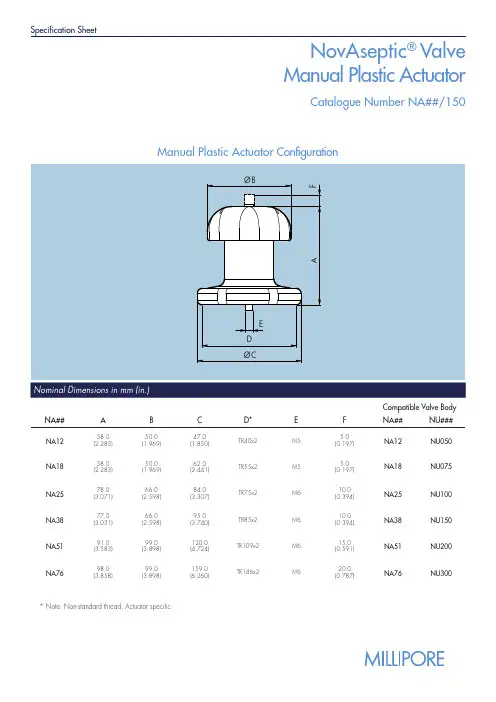
Specification SheetNovAseptic® ValveManual Plastic ActuatorCatalogue Number NA##/150Manual Plastic Actuator ConfigurationSpecification Sheet NovAseptic Valve, Manual Plastic Actuator ��NA##/150 �� NA##/150For additional information call your nearest Millipore office or visit us at .In the U.S. and Canada, call toll-free 1-800-MILLIPORE (1-800-645-5476). In the U.S., Canada and Puerto Rico, fax orders to 1-800-MILLIFX (1-800-645-5439).To Place an Order or Receive Technical AssistanceSurface Roughness: External surface Ra ≤ 1.6µm (63µin)Environment Temperature: 0 to 70 ºC (32 to 158 ºF)Design Pressure: -1 to 10 bar(g) (-14.5 to 145 psi(g))Note!The applied valve body and diaphragm may have different design temperature and/or pressure limits. Theweakest component in the assembled product determines the maximum design temperature and pressure beling: Each Actuator is labeled for full LOT traceability according to Millipore QA routines. Packaging: The Actuator is packaged in a closed box.Quality Control: Millipore Quality Assurance System guarantees the control and traceability of the product.Options:For non-standard NovAseptic Actuator Options, please contact Millipore for further information.Millipore and NovAseptic are registered trademarks of Millipore Corporation or an affiliated company. ASTM is a registered trademark of the American Society for T esting and Materials.Specifications subject to change without notice.Lit. No. SP1118EN00 Rev. -, 09/2006.Replaces �S-062 Replaces �S-062 © 2006 Millipore Corporation. All rights reserved.。
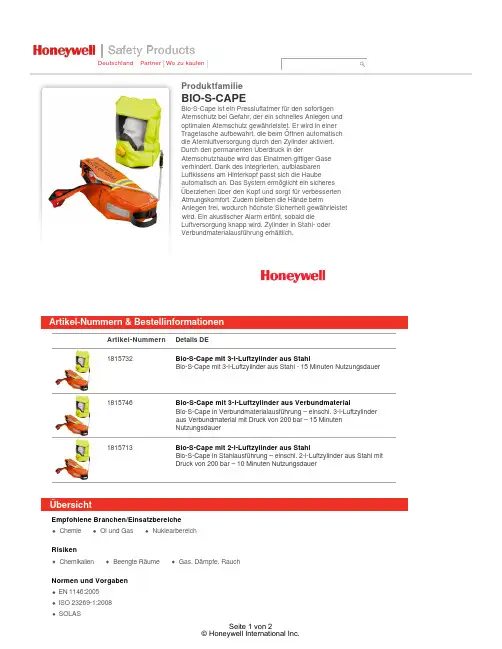
Deutschland PartnerWo zu kaufenArtikel-NummernDetails DE 1815732Bio-S-Cape mit 3-l-Luftzylinder aus StahlBio-S-Cape mit 3-l-Luftzylinder aus Stahl - 15 Minuten Nutzungsdauer1815746Bio-S-Cape mit 3-l-Luftzylinder aus VerbundmaterialBio-S-Cape in Verbundmaterialausführung – einschl. 3-l-Luftzylinderaus Verbundmaterial mit Druck von 200 bar – 15 MinutenNutzungsdauer1815713Bio-S-Cape mit 2-l-Luftzylinder aus StahlBio-S-Cape in Stahlausführung – einschl. 2-l-Luftzylinder aus Stahl mitDruck von 200 bar – 10 Minuten Nutzungsdauer ChemieÖl und Gas NuklearbereichChemikalien Beengte Räume Gas, Dämpfe, Rauch Empfohlene Branchen/EinsatzbereicheRisikenNormen und VorgabenEN 1146:2005ISO 23269-1:2008SOLASÜbersichtBIO-S-CAPEProduktfamilieBio-S-Cape ist ein Pressluftatmer für den sofortigenAtemschutz bei Gefahr, der ein schnelles Anlegen undoptimalen Atemschutz gewährleistet. Er wird in einerTragetasche aufbewahrt, die beim Öffnen automatischdie Atemluftversorgung durch den Zylinder aktiviert.Durch den permanenten Überdruck in derAtemschutzhaube wird das Einatmen giftiger Gaseverhindert. Dank des integrierten, aufblasbarenLuftkissens am Hinterkopf passt sich die Haubeautomatisch an. Das System ermöglicht ein sicheresÜberziehen über den Kopf und sorgt für verbessertenAtmungskomfort. Zudem bleiben die Hände beimAnlegen frei, wodurch höchste Sicherheit gewährleistetwird. Ein akustischer Alarm ertönt, sobald dieLuftversorgung knapp wird. Zylinder in Stahl- oderVerbundmaterialausführung erhältlich.BIO-S-CAPEMEDIMOMSCTragetascheStabiles PVC (orange), schneller Öffnungsmechanismus, fluoreszierende Streifen, Sicherheitsdichtung, großerSichtbereich, System zur Reduzierung von FlüssigkeitsansammlungHalsabdichtungSynthetisches, nicht allergenes Weichgummi mit reißfestem System.LinseBreiter Sichtbereich – ohne optische VerzerrungDruckminderungsventilDruckminderungsventil wird beim Öffnen der Tasche automatisch ausgelöst, integrierter EN-Aufladeanschluss Gebrauchszeit10 oder 15 MinutenAbmessungen500 x 160 x 180 mm (19,7 x 6,3 x 7,1")Genutzter Druck200 barNutzungstemperatur–15 °C/60 °CBio-S-Cape EN certificate/Supplementary/Documents_and_Downloads/Secured/Respiratory_Protection/4294989032/1033.aspxMED certificate/Supplementary/Documents_and_Downloads/Secured/Respiratory_Protection/4294986876/1033.aspxBIO-S-CAPE user manual/Supplementary/Documents_and_Downloads/Respiratory_Protection /4294986873/1033.aspxBio-S-Cape – Technisches Datenblatt© Honeywell International Inc.。
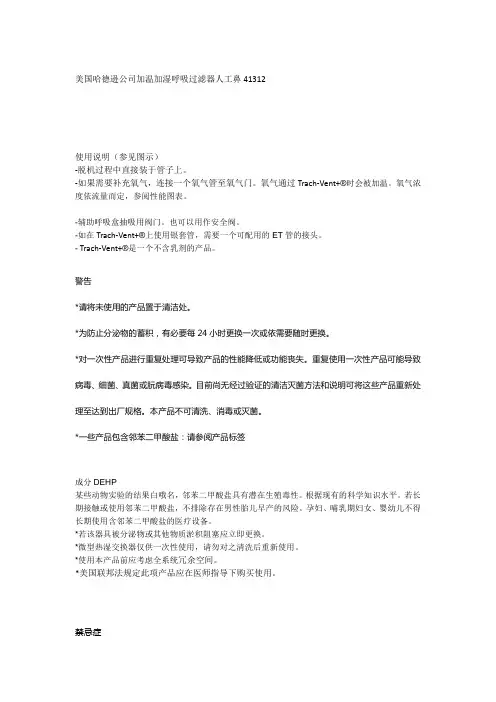
美国哈德逊公司加温加湿呼吸过滤器人工鼻41312使用说明(参见图示)-脱机过程中直接装于管子上。
-如果需要补充氧气,连接一个氧气管至氧气门。
氧气通过Trach-Vent+®时会被加温。
氧气浓度依流量而定,参阅性能图表。
-辅助呼吸盒抽吸用阀门。
也可以用作安全阀。
-如在Trach-Vent+®上使用银套管,需要一个可配用的ET管的接头。
- Trach-Vent+®是一个不含乳剂的产品。
警告*请将未使用的产品臵于清洁处。
*为防止分泌物的蓄积,有必要每24小时更换一次或依需要随时更换。
*对一次性产品进行重复处理可导致产品的性能降低或功能丧失。
重复使用一次性产品可能导致病毒、细菌、真菌或朊病毒感染。
目前尚无经过验证的清洁灭菌方法和说明可将这些产品重新处理至达到出厂规格。
本产品不可清洗、消毒或灭菌。
*一些产品包含邻苯二甲酸盐:请参阅产品标签成分DEHP某些动物实验的结果白哦名,邻苯二甲酸盐具有潜在生殖毒性。
根据现有的科学知识水平。
若长期接触或使用邻苯二甲酸盐,不排除存在男性胎儿早产的风险。
孕妇、哺乳期妇女、婴幼儿不得长期使用含邻苯二甲酸盐的医疗设备。
*若该器具被分泌物或其他物质淤积阻塞应立即更换。
*微型热湿交换器仅供一次性使用,请勿对之清洗后重新使用。
*使用本产品前应考虑全系统冗余空间。
*美国联邦法规定此项产品应在医师指导下购买使用。
禁忌症*Humid-Vent Filter不适用于呼吸道分泌大量泡沫的病人及咳血症病人。
*切勿与普通加湿器盒雾化器并用。
*切勿给过滤器添加水分。
*如果使用无气囊的气管导管,在管子周围会发生漏气现象,这样会降低加湿效率。
呼吸加湿过滤系统注册号:详见外包装标签标准编号:详见外包装标签生产企业:见标签生产地址:见标签储存方法:本产品应保存在包装盒中,放置在干燥处。
放置直接或间接接触火源或热源有效期:见外包装。
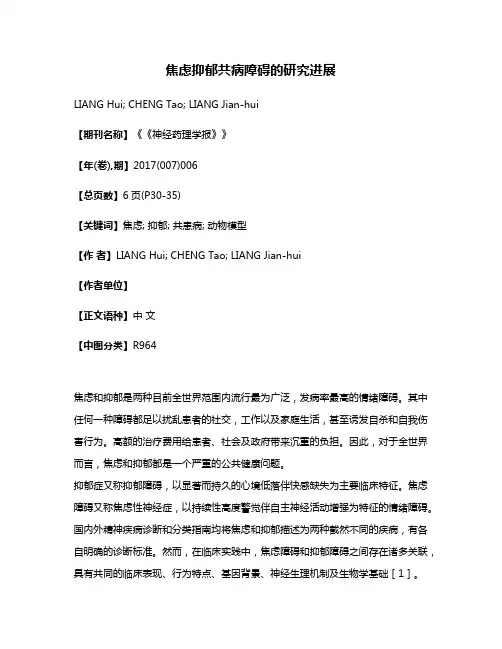
焦虑抑郁共病障碍的研究进展LIANG Hui; CHENG Tao; LIANG Jian-hui【期刊名称】《《神经药理学报》》【年(卷),期】2017(007)006【总页数】6页(P30-35)【关键词】焦虑; 抑郁; 共患病; 动物模型【作者】LIANG Hui; CHENG Tao; LIANG Jian-hui【作者单位】【正文语种】中文【中图分类】R964焦虑和抑郁是两种目前全世界范围内流行最为广泛,发病率最高的情绪障碍。
其中任何一种障碍都足以扰乱患者的社交,工作以及家庭生活,甚至诱发自杀和自我伤害行为。
高额的治疗费用给患者、社会及政府带来沉重的负担。
因此,对于全世界而言,焦虑和抑郁都是一个严重的公共健康问题。
抑郁症又称抑郁障碍,以显著而持久的心境低落伴快感缺失为主要临床特征。
焦虑障碍又称焦虑性神经症,以持续性高度警觉伴自主神经活动增强为特征的情绪障碍。
国内外精神疾病诊断和分类指南均将焦虑和抑郁描述为两种截然不同的疾病,有各自明确的诊断标准。
然而,在临床实践中,焦虑障碍和抑郁障碍之间存在诸多关联,具有共同的临床表现、行为特点、基因背景、神经生理机制及生物学基础[1]。
研究资料表明:焦虑和抑郁共病的发病率高,临床表现复杂,症状反复,缺乏有效的治疗药物及手段,患者预后不良。
因此,焦虑和抑郁共病成为精神卫生,神经精神药理学及其相关领域热点问题之一[2-3]。
本文旨在从基本概念,共病特点,治疗措施以及相关的动物模型四个方面对焦虑抑郁共病问题作系统文献复习和综合分析,阐述焦虑抑郁共病的研究进展。
1 焦虑抑郁共病障碍的基本概念共病障碍(comorbidity)是指“同一个病人患有某一特定索引疾病的同时,还被诊断出其它任何已存在或发生在索引疾病条目中的疾病”[4]。
简而言之,即“一人多病” 的现象。
焦虑抑郁共病被具体定义为同一患者在某一时期同时达到焦虑障碍和抑郁障碍的诊断标准,其共病病程可以是半年,一年甚至终生。
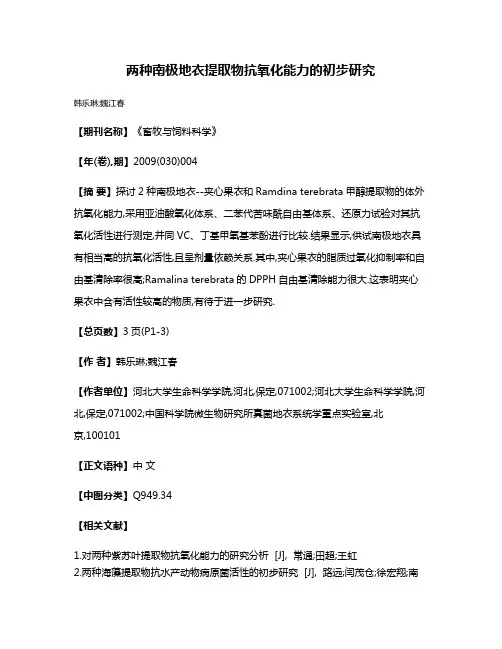
两种南极地衣提取物抗氧化能力的初步研究
韩乐琳;魏江春
【期刊名称】《畜牧与饲料科学》
【年(卷),期】2009(030)004
【摘要】探讨2种南极地衣--夹心果衣和Ramdina terebrata甲醇提取物的体外抗氧化能力,采用亚油酸氧化体系、二苯代苦味酰自由基体系、还原力试验对其抗氧化活性进行测定,并同VC、丁基甲氧基苯酚进行比较.结果显示,供试南极地衣具有相当高的抗氧化活性,且呈剂量依赖关系.其中,夹心果衣的脂质过氧化抑制率和自由基清除率很高;Ramalina terebrata的DPPH自由基清除能力很大.这表明夹心果衣中含有活性较高的物质,有待于进一步研究.
【总页数】3页(P1-3)
【作者】韩乐琳;魏江春
【作者单位】河北大学生命科学学院,河北,保定,071002;河北大学生命科学学院,河北,保定,071002;中国科学院微生物研究所真菌地衣系统学重点实验室,北
京,100101
【正文语种】中文
【中图分类】Q949.34
【相关文献】
1.对两种紫苏叶提取物抗氧化能力的研究分析 [J], 常通;田超;王虹
2.两种海藻提取物抗水产动物病原菌活性的初步研究 [J], 路远;闫茂仓;徐宏翔;南
春容
3.南极石生地衣主要生物风化作用研究进展与展望 [J], 陈杰;檀满枝;Hans-PeterBlume
4.南极乔治王岛菲尔德斯半岛和阿德雷岛地衣研究Ⅱ.石蕊属 [J], 陈健斌;T.艾棣
5.南极磷虾油改善衰老小鼠抗氧化能力的作用研究 [J], 刘小芳;宫玉雪;田良良;于源;苗钧魁;冷凯良
因版权原因,仅展示原文概要,查看原文内容请购买。
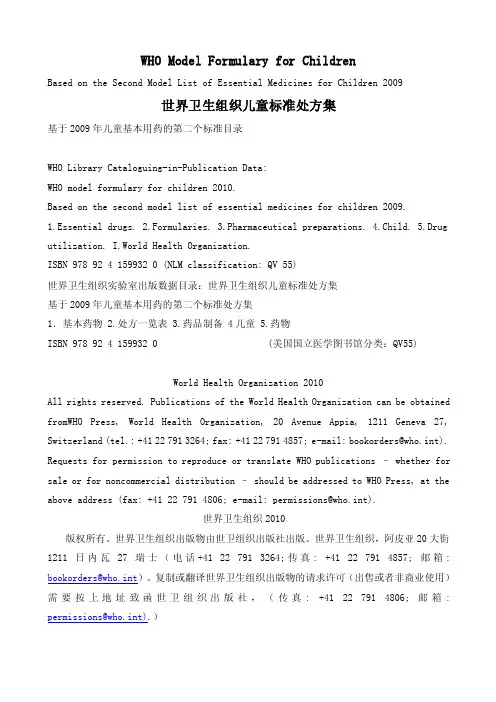
WHO Model Formulary for ChildrenBased on the Second Model List of Essential Medicines for Children 2009世界卫生组织儿童标准处方集基于2009年儿童基本用药的第二个标准目录WHO Library Cataloguing-in-Publication Data:WHO model formulary for children 2010.Based on the second model list of essential medicines for children 2009.1.Essential drugs.2.Formularies.3.Pharmaceutical preparations.4.Child.5.Drug utilization. I.World Health Organization.ISBN 978 92 4 159932 0 (NLM classification: QV 55)世界卫生组织实验室出版数据目录:世界卫生组织儿童标准处方集基于2009年儿童基本用药的第二个标准处方集1.基本药物 2.处方一览表 3.药品制备 4儿童 5.药物ISBN 978 92 4 159932 0 (美国国立医学图书馆分类:QV55)World Health Organization 2010All rights reserved. Publications of the World Health Organization can be obtained fromWHO Press, World Health Organization, 20 Avenue Appia, 1211 Geneva 27, Switzerland (tel.: +41 22 791 3264; fax: +41 22 791 4857; e-mail: ******************). Requests for permission to reproduce or translate WHO publications – whether for sale or for noncommercial distribution – should be addressed to WHO Press, at the aboveaddress(fax:+41227914806;e-mail:*******************).世界卫生组织2010版权所有。
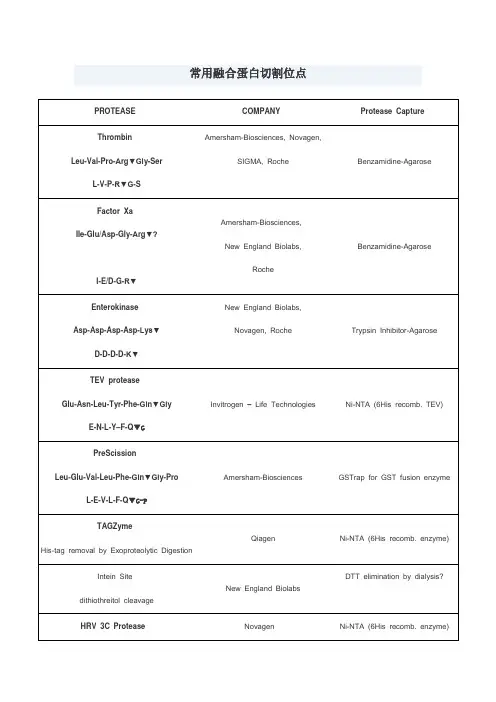
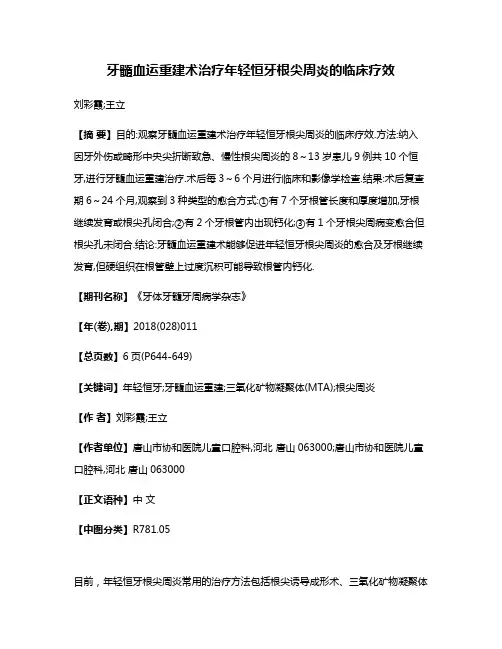
牙髓血运重建术治疗年轻恒牙根尖周炎的临床疗效刘彩霞;王立【摘要】目的:观察牙髓血运重建术治疗年轻恒牙根尖周炎的临床疗效.方法:纳入因牙外伤或畸形中央尖折断致急、慢性根尖周炎的8~13岁患儿9例共10个恒牙,进行牙髓血运重建治疗.术后每3~6个月进行临床和影像学检查.结果:术后复查期6~24个月,观察到3种类型的愈合方式:①有7个牙根管长度和厚度增加,牙根继续发育或根尖孔闭合;②有2个牙根管内出现钙化;③有1个牙根尖周病变愈合但根尖孔未闭合.结论:牙髓血运重建术能够促进年轻恒牙根尖周炎的愈合及牙根继续发育,但硬组织在根管壁上过度沉积可能导致根管内钙化.【期刊名称】《牙体牙髓牙周病学杂志》【年(卷),期】2018(028)011【总页数】6页(P644-649)【关键词】年轻恒牙;牙髓血运重建;三氧化矿物凝聚体(MTA);根尖周炎【作者】刘彩霞;王立【作者单位】唐山市协和医院儿童口腔科,河北唐山063000;唐山市协和医院儿童口腔科,河北唐山063000【正文语种】中文【中图分类】R781.05目前,年轻恒牙根尖周炎常用的治疗方法包括根尖诱导成形术、三氧化矿物凝聚体(mineral trioxide aggregate,MTA)根尖屏障术及牙髓血运重建术,前两种治疗方法均需进行后续的根管充填,但存在根管壁薄弱,管腔粗大易折等缺点。
近年来研究表明,牙髓血运重建术是促进患有根尖周炎的年轻恒牙牙根继续发育的有效途径[1-3]。
本研究旨在观察牙髓血运重建术对年轻恒牙根尖周炎的治疗效果。
1 临床资料和方法1.1 主要材料和设备15 g/L次氯酸钠、170 g/L EDTA溶液(皓齿,美国);氢氧化钙糊剂(派丽登,美国);富士Ⅸ玻璃离子水门汀(3M,美国);20 g/L利多卡因(上海上药);MTA(登士柏,美国);超声根管荡洗锉(塞特力,法国);根管糊剂螺旋根充器、各型车针(马尼,日本);垂直加压器(长沙Denjoy);牙科X射线机(Planmeca,芬兰);牙科显微镜(苏州Zumax)。


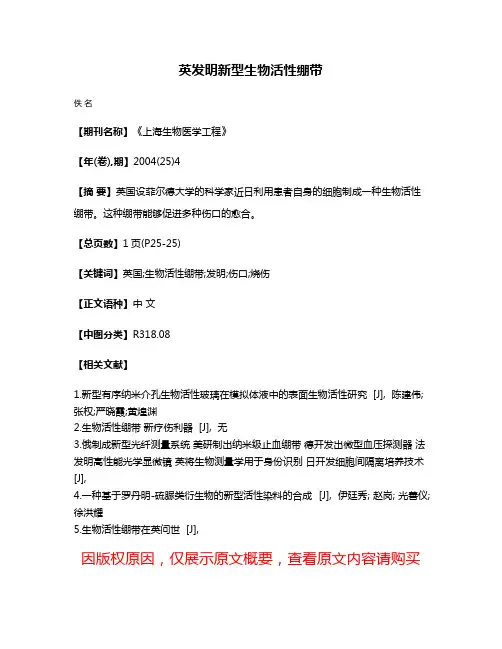
英发明新型生物活性绷带
佚名
【期刊名称】《上海生物医学工程》
【年(卷),期】2004(25)4
【摘要】英国设菲尔德大学的科学家近日利用患者自身的细胞制成一种生物活性绷带。
这种绷带能够促进多种伤口的愈合。
【总页数】1页(P25-25)
【关键词】英国;生物活性绷带;发明;伤口;烧伤
【正文语种】中文
【中图分类】R318.08
【相关文献】
1.新型有序纳米介孔生物活性玻璃在模拟体液中的表面生物活性研究 [J], 陈建伟;张权;严晓霞;黄煌渊
2.生物活性绷带新疗伤利器 [J], 无
3.俄制成新型光纤测量系统美研制出纳米级止血绷带德开发出微型血压探测器法发明高性能光学显微镜英将生物测量学用于身份识别日开发细胞间隔离培养技术[J],
4.一种基于罗丹明-硫脲类衍生物的新型活性染料的合成 [J], 伊廷秀; 赵岗; 光善仪; 徐洪耀
5.生物活性绷带在英问世 [J],
因版权原因,仅展示原文概要,查看原文内容请购买。
Biofeedback in Gameplay: How Valve Measures Physiology to Enhance Gaming Experience Mike Ambinder, PhDMarch 3rd, 2011GDCGoals of this Presentation▪Provide overview of biofeedback▪Discuss potential applications▪Use examples to show costs and benefits ▪Discuss future directions and implications▪Biofeedback: measurement, display, analysis, modification, manipulation, and response of physiological signals ▪Using biological indicators to index sentiment/emotion▪Feedback loop possible where subsequent signals depend on prior states▪Emotional states not stable▪Transient▪Volatile▪Subject to manipulationPhysiological ResponseInput to SystemSystem Response Output to PlayerWhy Biofeedback?▪Current control schemes▪Provide one dimension of input▪Map player intent to onscreen action ▪Ignore other aspects of cognition▪Ignore player sentimentWhy Biofeedback?▪What about player sentiment?▪Adding emotional input incorporates new (and previously ignored) dimension of player input▪Tailor more immersive, dynamic, and calibrated game experience+Emotion▪Subjective, internal state induced by response to (usually) external events ▪Vector▪Magnitude (arousal)▪Direction (valence)ArousalValence+–+ –EnergeticRelaxedAngryBoredEngagedPassiveHappy SadAdapted from Lang (1995)AfraidJubilantFatiguedContentPhysiological Signals▪Heart rate▪SCL (skin conductance level)▪Facial expressions▪Eye movements▪EEGs (Electroencephalography) ▪Others (pupil dilation, body temperature, posture, etc.)▪Beat to beat interval of blood flow▪Measure baseline rate and deltas over time/forums/ipod-news/711048-nike-heart-rate-monitor-ipod-set-june-1st-release.html /wiki/Electrocardiography+Index of arousal+Cheap+Easy to measure+Familiar+Fourier transform to get valence? -Prone to movement artifacts-Delayed onset to stimuli-Difficult to determine valence▪Electrical resistance of the skin▪Chart waveform of arousal over time ▪Get responsive and anticipatory spikes/content/2/1/11/figure/F5?highres=y+Index of arousal+Tonic/Phasic responses +Minimal lag to stimuli+Cheap+Robust to movement+Lots of measurement sites -Difficult to associate eliciting events-Difficult to determine valence-Range is variableacross subjectsFacial Expressions▪Record movement of facial muscles▪Classify emotion (both valence and arousal) ▪Can be done remotely or via EMGFearAnger Surprise Disgust Sadness HappinessIllustration of canonical faces/2007/1/2/07102article.htm+Index of valence +Index of arousal +Measures instantaneous responses -Can be intrusive-Expensive(at the moment)-Subject to bias-Requires training or a black boxFacial ExpressionsEye Movements▪Remote (or mounted) cameras measure reflectivity off of pupils▪Record where eyes are looking in real-time ▪Get saccades (movements) and fixations/index.php?/projects/studionext-eye-tracking/+Index of attention+Rudimentary index of thought+Index of arousal (with pupil dilation)+Unique+Reliable -Very expensive-Requires extensive analysis-Can be intrusive lead to subject biasing eye movementsEye MovementsEEGs▪Measure electrical potentials of the brain ▪Primarily time-based signals▪Coarse measures of location▪Get frequency spectra and spike latency/health_reference/Test-Procedure/MY00296.cfm/human_neuroscience/10.3389/neuro.09.005.2009/fullhttp://bindcenter.eu/?page_id=12 /2008/02/28/put-on-your-thinking-cap-a-gaming-helmet-can-read-minds/+Index of arousal+Index of valence+Rudimentary insight into thought -Very expensive -Very intrusive -Very noisy-Difficult to validate▪Pupil Dilation - arousal▪Body temperature - arousal▪Body posture - valence▪Couple with pupil dilation to get frustration ▪Lots of stuff we haven’t thought aboutPotential Applications▪Passive viewing of biofeedback data ▪Modify game experience based upon player sentiment/emotion/internal state ▪L4D director with biofeedback▪Adaptive realtime difficulty adjustment▪Detect and respond to disengaged players ▪Determine optimal arousal patterns▪Can manipulate gameplay to inducePotential Applications▪Physiological data as direct input▪Tie health to arousal▪In-game prompts tied to emotional state ▪NPCs respond dynamically▪Required valence/arousal to proceedPotential Applications▪Matchmaking/Profiling▪Spectate competitive matches ▪Multiplayer Mechanics▪Detect teammate in trouble▪Earn points for eliciting responses ▪Playtesting▪Modification of AI Director in Left 4 Dead 2▪Addition of physiological input to Alien Swarm ▪Eye movements as active controls in Portal 2▪Passive viewing of physiological inputs ▪Implications for multi-player▪Playtesting Applications▪Director creates dynamic, variable experience in Left 4 Dead series▪Modifies enemy spawns, health and weapon placement, boss appearances, etc.▪In-game encounters determined by estimated arousal level▪Will replacing estimated arousal with actual arousal create a more enjoyable experience? ▪Can we determine optimal arousal patterns?Director Algorithm▪Represent Survivor intensity as single value ▪Increase it in response to in-game trauma ▪Decay intensity to zero over time▪Create peaks and valleysCurrent Hardware SolutionAnalysis of SCL Data▪Categorize game events▪Record survey responses▪Enjoyment, frustration, etc.▪Quantify waveform▪Spike frequency, size of range, average lag, etc. ▪Data-mine (correlation, regression, frequency analysis, PCA, etc.)1290891060 player_biofeedback_scl 1.161238 228 1290891060 player_biofeedback_scl 1.161238 229 1290891061 item_pickup 63 first_aid_kit1290891061 spawner_give_item 63 weapon_first_aid_kit1290891061 player_use 63 407 1290891061 item_pickup 63 first_aid_kit1290891061 spawner_give_item 63 weapon_first_aid_kit1290891061 player_use 63 407 1290891061 player_biofeedback_scl 1.145869 230 1290891061 player_biofeedback_scl 1.156099 231 1290891061 player_biofeedback_scl 1.140777 232 1290891061 player_biofeedback_scl 1.156099 233 1290891061 item_pickup 65 first_aid_kit1290891061 spawner_give_item 65 weapon_first_aid_kit1290891061 player_use 65 406 1290891061 item_pickup 65 first_aid_kit1290891061 spawner_give_item 65 weapon_first_aid_kit1290891061 player_use 65 406 1290891061 player_biofeedback_scl 1.145869 234 1290891061 use_target 411 C_WeaponSpawn3. Overall, I found today’s experience enjoyable.1 2 3 4 5 6 7 8 9 (strongly disagree) (strongly agree) 4. Overall, today’s experience was frustrating.1 2 3 4 5 6 7 8 9 (strongly disagree) (strongly agree) 5. Overall, today’s play session was challenging.1 2 3 4 5 6 7 8 9 (strongly disagree) (strongly agree)SCLs nSCR Mean SCRAmplitudeStdSpikeAmpSpikeAmpRangeMin SpikeAmpMaxSpikeAmpMean SpikeAreaSumQuestion4-0.10 -0.09 0.00 -0.07 -0.08 -0.07 0.07 %Average excitement Question5-0.09 0.25 0.15 0.22 -0.07 0.22 -0.22 %Average frustration Question6-0.39 -0.03 0.02 0.01 -0.13 0.00 0.06 %Average challenge factorResults▪Measured arousal produces greater enjoyment than estimated arousal▪Have rudimentary insight into events which elicit enjoyment▪Progress on optimal arousal patternsExperiment Summary▪Physiological signals are viable inputs▪More work needed to ‘quantify’ enjoyment ▪How well can we shape the arousal curve?。